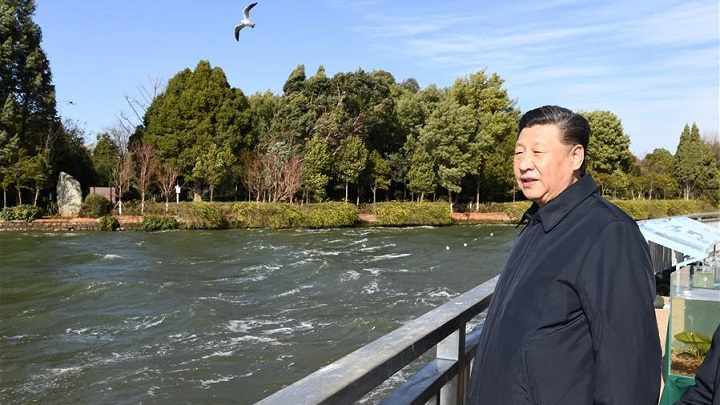
Today, China is in a dramatic predicament for itself and others. What is the grand strategy to use to cope with the world? The big question hangs over the thousands of delegates convened in Beijing for the ritual plenary session of the National People’s Congress, the most important political appointment of the year due to begin on March 5.
The People’s Republic of China (PRC) started in 1949 with the lofty goal of defeating international imperialism and spreading socialism worldwide. When Mao broke up with the USSR in the early 1960s, he started his own international socialist movement supporting Maoist groups in Europe, Africa, and Asia. After he died in 1976, China dropped its internationalist ambitions and went on a different path.
Deng’s coming to power was marked by a clear, though ambiguously framed, strategy. He stated that the country should “cross the river by touching the stones” 摸着石头过河. The sense was that China had to modernize, that is, Westernize, that is, Americanize, step by step, being careful about possible mistakes.
It was no accident that Deng put on a cowboy hat on his famous American trip, concretely showing the Chinese and the world what he wanted to do. The walk had to be cautious, one step at a time, feeling stones and avoiding falling in the water, but the general direction was certain.
The strategy matched and dovetailed with a similar US strategy. In 1980, the US granted China lower export tariffs to America than those given to Japan or South Korea at the time. It allowed technology transfers and encouraged the World Bank to recommend a path for economic reforms.
These concessions had generated a virtuous circle between the two countries. US companies were relocating factories to China, lowering production costs, thus expanding the international market and helping to control inflation. China invested the proceeds in improving its manufacturing base and buying US Treasury bonds, with which the US financed new purchases of Chinese products.
The agreement was based on a definite geopolitical interest; both countries feared the USSR. As evidence of its commitment against Moscow, Beijing had attacked Vietnam in 1979, thus stopping a possible Vietnamese advance toward Thailand. It had also provided an alternative route to Pakistan in supplying arms to the anti-Soviet Afghan Mujahideen. The alternative was vital because it gave the US leverage to pressure Pakistan, which demanded increasingly high prices for its support of the Mujahideen.
Globalization and BRI
Therefore, the relationship was very structured, geopolitically, militarily and economically. The relationship began to fray with the end of the USSR, which eliminated the common enemy against which to be united. But it still held for years because the US expanded the model of economic integration with China to the whole world, calling it “globalization.”
However, there was no geopolitical and military collaboration with China or others in the new globalization. It was now considered unnecessary given the American “overpower” of the period. However, American overpower proved to have strategic, military, and economic limits from 2004 to 2009.
After destroying the old authorities in Afghanistan and Iraq, it failed to build a new order in these countries. This was followed by the financial crisis of 2008. Together, the two elements proved to China, touching the stones of its transition to Americanization, that the American model had jammed.
Indeed, Beijing came to believe, perhaps it was indeed in decline, that instead, the Chinese model was on the rise and that Beijing could do without following the US. In this atmosphere, the idea of changing the development paradigm, in essence, and adopting the design of a new Silk Road, renamed the Belt and Road Initiative (BRI), matured.
The BRI, which sprang around 2013, was not a multilateral structure (albeit a Chinese-initiated one) like the UN or the IMF, launched by the US after World War II. The BRI was basically an arm of Chinese foreign policy.
In its initial phase, the IMF was essentially funded by the US, but the US, seeking political consensus, involved many countries in the coordinated management of the fund. The BRI appeared conversely as an act of Chinese assertion, without China having actually won a world war.
Still, the BRI was a project that, if it had succeeded, would have changed world geopolitics. It created a direct line between China and Europe by reversing a 500-year communications pattern centered on the American continent. Moreover, China and Europe never had direct trade but always through Central Asian peoples, Persia, or India. To open direct economic-political communication with Europe was revolutionary. Thus, it was precisely why it should have involved in the first place the countries potentially most harmed by the initiative.
The BRI was opposed by the US, Japan, and India, which felt marginalized and excluded. But even assuming that the US was really in decline in 2014-15, it still had an economy, military, technological, and alliance apparatus that far outstripped China’s. Prudence should have prompted Beijing to be cautious by involving America, Japan, and India at the beginning of its BRI effort.
What China apparently lacked, however, was “open thinking power.” China was apparently unwilling to involve other countries in a forum it had initiated. It possibly felt uncertain how to exercise control more softly about its own initiative.
There might have been also the problem of engaging in a positive and constructive confrontation with democratic countries. Vibrant and vocal Americans might have wanted discussions at the beginning of the BRI. Strong thoughts would emerge in those discussions, and states would then adopt them. However, thoughts about the BRI in China were worked out within the Politburo. Some considerations might have been kept secret because of strict party discipline.
Then, a BRI, effectively open to international collaboration, might have posed new governance challenges for the party. Moreover, the BRI failed because China’s naive conceit in pursuing it alienated so many countries formerly suspicious and wary of American arrogance. More than the American failures in Iraq or Wall Street, Chinese naiveté pushed many countries back to the US embrace.
The failure to handle COVID (when Americans produced the only effective vaccines) and the error of judgment in Ukraine (when Beijing believed in a quick Russian victory) further eroded national confidence in the future.
No Roadmap
Today, there is the BRI failure due to the lack of cooperation of the major international players and China’s domestic difficulties with the collapse of the real estate market, the main driver of development over the past 25 years.
This leaves China without a roadmap for the future. “Crossing the river by touching the stones” is gone because Beijing no longer wants to become American. The BRI is also gone, and what Beijing intends to do is unclear.
For now, apparently, China is trying to deal one by one with the various challenges that come its way. There is the problem of Electronic industrialist Huawei, withdrawn from the once lucrative US market; the battery manufacturers are trying to cope with tariffs and barriers that are rising higher every day, and there are the threats of new, higher duties and prohibitions against port cranes or any other kind of Chinese goods.
There is a lack of overall design, so Beijing is constantly on the defensive and trying to implement an old Chinese tactic, 钻空子zuan kongzi, to exploit loopholes. This can work for some time with an entrepreneurial, active, and astute population. It gives the government breathing space, but it is unlikely to change the situation dramatically in the medium to long term.
It is unclear how much time China has. The recent funeral of Russian dissident Alexei Navalny in Moscow, attended by thousands despite Putin’s bans, shows possibly significant rifts in the regime. It is unclear how this will impact the Ukrainian battlefields, but it certainly does not help the Russian offensive.
Israel’s intervention against Hamas in Gaza is proceeding with difficulty, but international support remains limited to minority segments of Western public opinion. Such pro-Palestinian protests in the West frighten Muslim governments that do not want to go under the political blackmail of Hamas after having been blackmailed by al-Fatah, Al Qaeda, or ISIS in the past.
Then, after the end of the Gaza conflict, which may fade from its most crucial stages in the next few months, Israel may be more central than ever in the Middle East. In other words, China may soon return to the center of international attention as other international fires die down or wane. The absence of strategic vision may thus become more burdensome.
In theory, there is a “reason of state” that could make up for the strategic vision. China advances and defends its national interests by reconciling them for mutual benefit with the national interests of others. In this, China knows what to do. It can talk to everyone, keeping all channels open and perhaps trying to turn one against the other to its advantage.
But this can work fine for some time in a small country. For a big country like China, it is much more difficult because, as happened with the BRI, it ends up that everyone might coalesce against Beijing.
Large, ambitious countries, such as the US, Russia, or Iran, certainly have the thrust of their national interests well in mind. Still, there is always a genuine general “ideal steering” that can appeal to the rest of the world and become common ground for future agreements.
The US defends the value of free markets and freedom, cherished by many worldwide. Russia proposes a return to Orthodox Christianity and argues against the evils of modernity, appealing to conservative and reactionary impulses present in many modern societies.
Iran is a champion of Shiite orthodoxy, which has also kindled a rediscovery of the faith of the Sunni believers in so much of the Islamic world.
An ideal message became necessary after the rise of states with a “reason of state” and the end of states structured around a king or ruling dynasty. It is unclear today what China can or will propose.
It flashes the myth of ancient imperial China. But that rested on China’s economic, cultural, and demographic strength relative to its surrounding countries, which represented a limited basin, sphere of influence, relative to the whole world.
Today, China has no basin where its leadership is widely and peacefully accepted. On the contrary, some countries in China’s ancient cultural basin, such as Japan, Vietnam, and South Korea, are active against Beijing.
Today, China is structured around the raison d’être of its ruling dynasty, the Communist Party of China (CPC). It may work internally but has little traction externally. It is also because, unlike the PCUS, which was internationalist (in fact, Stalin was Georgian), the CPC is nationalist, not only toward foreigners but also toward non-Han ethnic minorities (the majority ethnic group in China).
We don’t know how long this may last or what it may lead to.
Perhaps the greatest challenge to China’s lack of strategy and inability to make an impact, however, is the beginning of a de facto alternative Asian strategy.
The Indian-sponsored Cotton Road opens, in fact, the prospect of an Asia that no longer gravitates only to China. Suppose the Cotton Road becomes an inclusive and multilateral initiative, as the BRI was not. In that case, it may create positive dynamics that could perhaps even cause China to rethink many of its ideas.
It would be crucial then for Delhi to treasure Beijing’s mistakes so as not to repeat them and to set a new, positive, hopefully, nonconfrontational direction for the whole continent and world.






This is a strange article. The way to become American wasn’t open to China. US doesn’t want to share hegemony with any other country. And the relations between China and the Soviet Union started to improve from the mid-’80’s.
US had shown its effort to maintain its protection over the Taiwan regime by sending two aircraft carrier battle groups through the Taiwan Strait in 1996 despite the fact that in the ’70’s it had accepted that Taiwan was a Chinese island.
The Belt and Road Initiative was open to all countries and UK was one of the first European countries to accede. The problem for the US was that it was below its dignity to become a members of a club initiated by a non-White country with a PPP GDP as large as its own.
Of course the Belt and Road initiative is now overshadowed by fast growing BRICS+ but that will not damage the initiative at all.
As for the many recent developments –
China helped restore diplomatic relations between Iran and Saudi Arabia while it was the intention of US to prevent such a development.
Russia succeeded in exhausting the Ukrainian armed forces and the arms supplies of the NATO countries without killing many Ukrainian civilians or doing great damage to most of Ukraine’s cities and infrastructure and has now effectively won the war – but if there is no Ukrainian offer of negotiations it will also take the Black Sea coast and possibly more.
Israel is the only antisemitic country in the world in its genocidal assault on the Palestinians in Gaza and the murderous conduct of the West Bank settlers that are protected by the Israeli Occupation Forces. Compare the large scale killing of Palestinians with the very small number of Ukrainian civilians killed, many of them no doubt killed by falling anti-air missiles.
BRICS+ countries play a large role in the diplomacy opposing that fascist regime.
The US Navy is unable to conduct US flagged civilian container ships past Yemen and the US president confirmed that the US will continue to bomb that country while agreeing that the bombing will not have the hoped for effect.
All this does serious damage to the reputation of US.
China can well live without the US market – which wasn’t true until a few years ago.
China has many of the best universities in the world. A recent article in Nature said that of the ten best US has three, China has seven. Of the best twenty US has four, China has eleven.
China has the most modern motor car industry and the battery production it needs.
It is starting the production of molten salt nuclear reactors for use in container vessels, the design for one was recently approved by Det Norske Veritas, and which will no doubt be used in the pair of aircraft carriers whose building was recently mentioned in South China Morning Post, and which produce heat at a temperature high enough to replace coal fired steam generators in the modern power plants of which many have been built over the last years.
There many more matters to be mentioned, I just think of the development of China’s first main line passenger aircraft while Boeing might disappear in the next ten years, but let’s stop here.
While China has problems, it always had problems, the situation is not as dire as this article suggests.